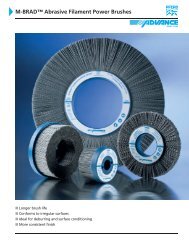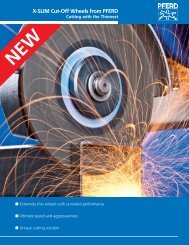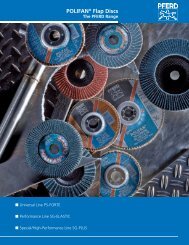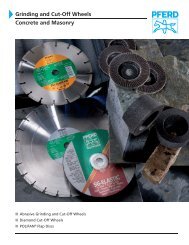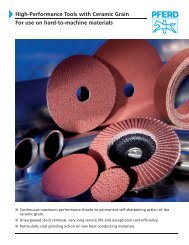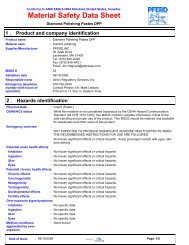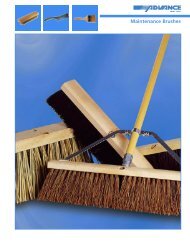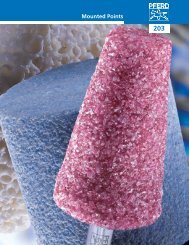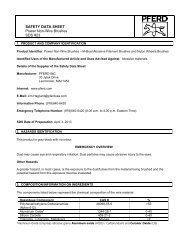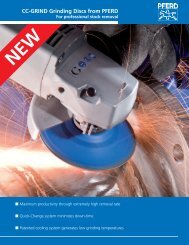Power Wire Brushes - Pferd
Power Wire Brushes - Pferd
Power Wire Brushes - Pferd
You also want an ePaper? Increase the reach of your titles
YUMPU automatically turns print PDFs into web optimized ePapers that Google loves.
<strong>Power</strong> <strong>Brushes</strong><br />
Safety Information, Problems and Solutions<br />
<strong>Power</strong> brushes are designed, tested, manufactured,<br />
and inspected to assure quality with a<br />
particular concern for safety considerations. To<br />
promote safety, users must be aware of potential<br />
hazards and their responsibilities for safe<br />
and proper operation of power brushes.<br />
Warnings, safety requirements, and product<br />
limitations and application suggestions are<br />
printed in this catalogue and in other literature,<br />
marked on brushes (when feasible), and/or<br />
supplied on or in the product container. These<br />
warnings and requirements must be observed<br />
by all power brush operators. Failure to do so<br />
may endanger the brush operator and others in<br />
the area of the brushing operation.<br />
Personal Protection<br />
In normal power brushing operations, the material<br />
being removed, such as burrs, scale, dirt,<br />
weld slag, or other residue, will fly off the brush<br />
with considerable force along with the brush<br />
filaments, which break off due to fatigue.<br />
The potential of serious injury exists for both<br />
the brush operator and others in the work area<br />
(possibly 50 feet or more from the brush).<br />
To protect against this hazard, operators and<br />
others in the area must wear SAFETY GOGGLES<br />
WITH SIDE SHIELDS or FULL FACE SHIELDS<br />
OVER SAFETY GLASSES WITH SIDE SHIELDS,<br />
along with PROTECTIVE CLOTHING such as<br />
GLOVES, MASKS, and PROPER FOOTWEAR.<br />
Safety Requirements Summary<br />
1. Protective Goggles: Safety goggles or full<br />
face shields worn over safety glasses with side<br />
shields MUST BE WORN BY ALL OPERATORS<br />
AND OTHERS IN THE AREA OF POWER BRUSH<br />
OPERATIONS. Comply with the requirements<br />
of ANSI Z87.1 “Occupational Eye and Face<br />
Protection”.<br />
2. Guards: Keep all machine guards in place.<br />
3. Speeds: Observe all speed restrictions<br />
indicated on the brushes, containers, labels, or<br />
printed in pertinent literature. “MSFS” means<br />
Maximum Safe Free Speed (RPM) – spinning<br />
free with no work applied. For reasons of<br />
safety, the “MSFS” should not be exceeded<br />
under any circumstances.<br />
4. Safety Standards: Comply with the Safety<br />
Standards of the American Brush Manufacturers’<br />
Association and the American National<br />
Standards Institute Standard ANSI B165.1,<br />
“Safety Requirements – <strong>Power</strong> <strong>Brushes</strong>”.<br />
5. Protective Equipment: Appropriate<br />
protective clothing and equipment must be<br />
used where a possibility of injury exists that can<br />
be prevented by such clothing or equipment.<br />
6. Dust Warning: Use of the tools in this<br />
catalogue may create dust and other particles.<br />
To avoid any risk of adverse health effects, the<br />
operator must use appropriate protective measures,<br />
including a respirator, during and after<br />
tool operation. Refer to our Material Safety<br />
Data Sheet (MSDS) for further information<br />
regarding the product to be used. Furthermore,<br />
additional health hazards may result from dust<br />
in the surrounding environment and from dust<br />
generated from the work piece material. PRO-<br />
TECTIVE MEASURES FOR THE OPERATOR MUST<br />
ADDRESS DUST AND OTHER PARTICULATES<br />
ARISING FROM ALL SOURCES. Always use our<br />
products in a well-ventilated workspace.<br />
Safety Recommendations<br />
= Wear protective goggles!<br />
= Wear protective gloves!<br />
= Wear dust respirator!<br />
= Observe safety recommendations!<br />
Read the Material Safety Data<br />
MSDS<br />
= Sheets (MSDS) before using any<br />
materials!<br />
Warning!<br />
Failure to observe<br />
safety precautions<br />
may result in injury.<br />
Read All Safety Information<br />
and Follow All Instructions on<br />
Packaging<br />
You must follow all operator and safety instructions,<br />
as well as common safety practices which<br />
will reduce the likelihood or severity of physical<br />
injury.<br />
Many brush manufacturers mark some safety<br />
warnings, recommendations, and usage restrictions<br />
directly on the product. It is not always<br />
practical to include even the most limited safety<br />
information on the brush itself. Therefore, the<br />
operator MUST READ and FOLLOW all instructions<br />
supplied in or on the product container<br />
as well as those marked on the product itself.<br />
The operator should also refer to the safety<br />
and operating information printed in the brush<br />
manufacturer’s catalogue and other literature.<br />
Availability of ANSI Standards<br />
In this catalogue, reference is made to these<br />
ANSI Standards: ANSI B-165.1, ANSI Z87.1.<br />
Copies of these standards are available at public<br />
libraries and from the American Brush Manufacturers’<br />
Association, 2111 Plum Street, Ste. 274,<br />
Aurora, IL 60506, Tel:(630) 631-5217, Fax: (866)<br />
837-8450; or American National Standards Institute,<br />
Inc. (ANSI), 1900 Arch Street, Philadelphia,<br />
PA 19103 (B165.1 only).<br />
ANSI Standard B 165.1 Arbor Holes<br />
ANSI Standard B165.1-2000 dictates maximum<br />
face widths and minimum arbor hole sizes<br />
allowable. All brushes listed in this catalogue<br />
conform to all ANSI standards.<br />
If you require a brush that does not conform to<br />
these standards, please contact your distributor<br />
for assistance.<br />
Note:<br />
The maximum face width listed in this table<br />
refers to shafts that are supported by one end<br />
only, such as angle and bench grinders. It does<br />
not apply to shafts that are supported by bearings<br />
at both ends.<br />
Wheel<br />
Diameter<br />
Minimum<br />
Arbor Hole<br />
Maximum<br />
Face Width<br />
2 1/4 1/4<br />
3 1/4 1<br />
4 3/8 1<br />
6 1/2 1-1/4<br />
7 5/8 1-1/4<br />
8 5/8 1-1/4<br />
10 3/4 2<br />
12 1 3<br />
14 1-1/4 3<br />
15 1-1/4 3<br />
16 2 3<br />
Prevent Problems<br />
Due to Mechanical Failure<br />
Do not allow unsafe conditions to continue.<br />
Occasionally, due to worn bearings, a bent<br />
spindle, an unusual application, operator abuse<br />
or inappropriate use, a brush may fail. A brush<br />
which is not received in acceptable condition for<br />
trouble-free operation may also fail. Do not use<br />
or continue to use a failed brush or one which is<br />
functioning improperly (i.e., throwing filaments,<br />
out-of-balance, etc.), as this increases the possibility<br />
for further brush failure and hazard of<br />
injury. The cause of the failure should be evaluated<br />
and corrected immediately.<br />
PAGE<br />
CATALOGUE<br />
12 I 208





